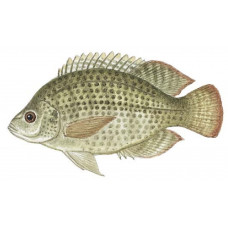Latin name
Oreochromis mossambicus
Other names
No information
Identification
The best known member of the tilapia group is the Mozambique tilapia (Oreochromis mossambicus), which is widely cultivated in ponds. The Mozambique tilapia is usually small in size with a moderately deep and compressed body. It has a long dorsal fin, the anterior part of which is barbed. It has a nostril on each side of the snout. Its intermittent lateral line may consist of two or three parts. Tilapia differ from bluegill in the absence of a dark blue or black operculum.
Distribution
Native to Africa and the Middle East, tilapia has been widely distributed throughout the world for food production. It is abundant in many Mexican lakes, where it has been introduced and fished by the hundreds of thousands, and is also found in some southern U.S. waters, most notably Florida.
Habitat
Tilapia thrive in the warm, weedy waters of slow-moving streams, canals, irrigation ditches, ponds, and lakes. Most fish are strictly freshwater, but some have adapted to brackish or salt water, and some can tolerate environments with extremely high temperatures and very low oxygen levels. Tilapia belong to the Cichlidae family, well known to aquarium enthusiasts. There are approximately 1,300 species.
Size
Most of the fish are small, although some can reach 20 pounds, and are schooling species.
Life history and Behavior
Mildly aggressive towards other species.
The Mozambique tilapia lays up to 400 eggs and carries them in her mouth. The fry also find their first shelter in the mouth. When they go for a walk, they scurry around the mother. But as soon as there is danger, the mother "lowers her head, raises her tail" and begins to retreat. This means "escape. And the babies immediately rush to the tried and true refuge - the mother's mouth.
Food and feeding habits
In freshwater they feed mainly on algae and plants. Many feed by mouth, although some build spawning nests, which they guard after the eggs hatch.
Reproduction
Spawns on the edge of the coastal terrace of lakes, on sandy or muddy bottoms. The male digs and protects a bowl-shaped hole in the center of its territory, where the female lays 100-1700 (1800) eggs. Fertilization is reported to sometimes occur in the female's mouth. The female incubates the eggs alone. The hatchlings hatch in the female's mouth after 3-5 days, depending on the temperature. Juveniles are released after 10-14 days, but remain close to the female until about 3 weeks of age. Females raise several broods during the season.
| Classification | |
| Phylum | Chordata |
| Class | Actinopterygii |
| Squad | Cichliformes |
| Family | Cichlidae |
| Genus | Oreochromis |
| Species | O. mossambicus |
| Features | |
| Conservation status | Vulnerable |
| Habitat | Pelagic |
| Life span, years | 11 |
| Maximum body weight, kg | 1.1 |
| Maximum length, cm | 39 |
| Sailing speed, m/s | No information |
| Threat to people | Edible |
| Way of eating | Predator |
Mozambique Tilapia
Tags: mozambique tilapia



